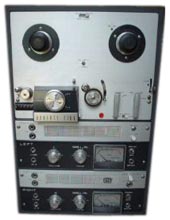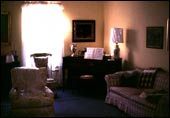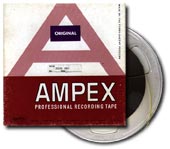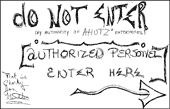


 A 1965 Roberts 770X tape deck, not unlike the one used on Fohhoh Bohob. |
|
||||||||||||
 The D'Alton's living room, post Bohob, with the Baldwin Acrosonic piano used on the album. |
Jon and I brought anything that was even remotely useful to the cause to Paul's house, and as soon as the D'Alton's pulled out of the driveway to start their vacation, we started ripping apart their living room. We set up Paul's drums in one corner, as far from the family Baldwin AcroSonic upright piano as possible. I put makeshift plastic gobos (sound-proof dividers) in front of the drums for a little sound control. Bit by bit, we set up our creative turf; amplifiers were hooked up, mikes (and there weren't too many of those, I can tell you) were placed, levels were checked. It took a whole day, but we were finally ready to make our mark on the world. It was June 25, 1969. We divided up the responsibilities into three distinct sections: I was to produce and engineer the album, Jon was to do the cover artwork and Paul was head of distribution (whatever that meant). At the beginning of the sessions, a friend of ours came over and shot a whole roll of film on us and our setup...it was great! Unfortunately, none of the photos came out (hence the sparse number of "action" photos in this section of the site). Not a particularly auspicious beginning! |
||||||||||||
 Me, sometime in 1969. | Nonetheless, we began laying down bottom tracks. Now, for those of you who are too young to remember a time before 120-track digital recording, let me explain what we were dealing with back in 1969. Both of our tape decks were stereo models which allowed sound-with-sound recording, that is, we were able to record a track on the left channel (channel 1), and then, while listening to that track, record something different onto the right channel (channel 2). On the song White Light, for instance, Jon, Paul and I laid down the piano, drums and bass guitar live onto the left channel. I had to pre-mix everything carefully before we recorded... once it was down on tape, there was no remixing. We had no limiters or compressors to ward off distortion, either; we were stuck with whatever we had, for better or worse. |
||||||||||||
 The actual edited Master Tape for side one of Fohhoh Bohob. |
The next step was to set up a monitoring system which would enable us to hear what we had just recorded on the left channel while adding something new to the right channel, in this case Jon and I on acoustic 12-string guitars and Paul adding more drums. Again, live, with no remixing. Once we were happy with the sound and performances, I then hooked up that tape deck to the stereo inputs of the other tape deck, and we added my vocal and Jon's autoharp live while we simultaneously transferred the bottom tracks to a new tape. In this manner, we were able to incorporate left, right and center tracks with only one generation of loss. Not the easiest way to work, but we were pretty good at it by now. The trick, of course, was to make the final product sound balanced and professional while having a minimum of control. |
||||||||||||
 The official KEEP OUT sign for our "studio"...as homemade as the album! |
Oddly enough, I still have distinct memories of when and how each track was recorded. One of the stranger/humorous recollections I have is of the three of us, during an extremely hot afternoon in the early days of our sessions, laying down the bass, drums and piano parts for the song Flower while only in our underwear. Three teenagers recording in their stark white briefs is a bizarre vision, even now! At one point during the sessions, the Roberts tape deck refused to allow the left channel record lever to engage; Jon and I spent the good part of a day fashioning a metal plate to push the lever to it's proper location. We recorded the remainder of the album with the machine's "guts" showing so that we could fix it quickly if and when it locked up. Welcome to the wonderful world of consumer tape decks! |
||||||||||||
Song by song, we captured our repertoire. Jon and I had done enough recording in the past to know our way around the basics of the process, but not enough to know what "wasn't allowed," so we constantly broke the rules (i.e., mike placement, reverb levels, sound effects, etc.) without even being aware of it. I truly believe our innocent "ignorance" is what gave the record it's charm. (Above, you can check out a very rare QuickTime movie snippet of Jon and I in early 1969, working on the arrangement for White Light at my parents house in Chappaqua, New York.) We often stopped tape when loud planes went over, when dogs barked, when phones rang (if we forgot to take them off the hook, which was fairly often). If you listen carefully to the fade out of White Light, you can hear the birds chirping outside. Not exactly a soundproof environment. Somehow or other, by July 15th, we had finished the tracks for what was to become Fohhoh Bohob. Photo of Eric Bergman in 1969 by Joe Ivins; 'Do Not Enter' sign created by Laurie Bishop; movie of Jon and Eric in early 1969 by Catherine Bergman.
|
|||||||||||||